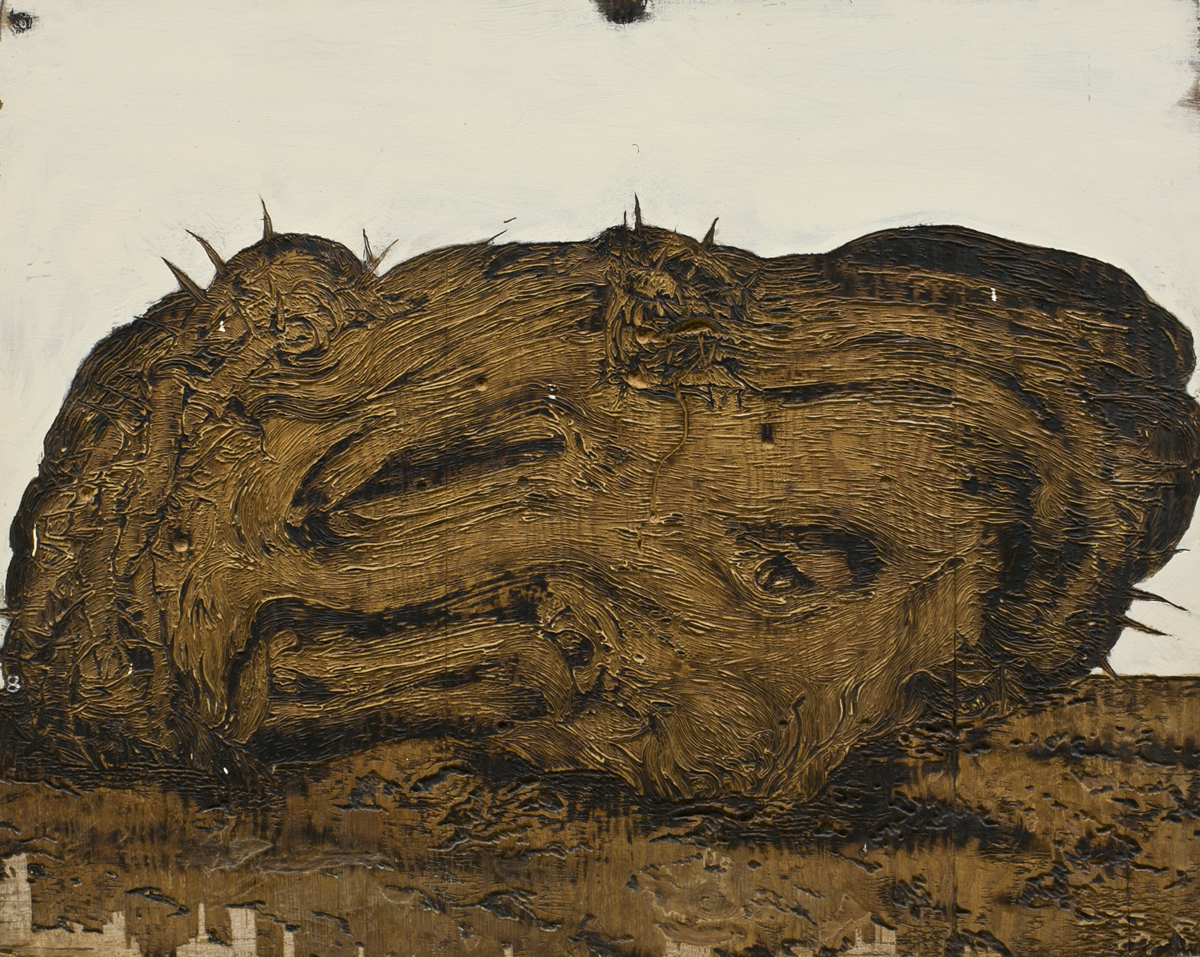
Elizabeth: This year has dumped a load of food, fine art, and complete confusion all at once; Hanukkah converged with Thanksgiving for the first time in years sending us all to the trough –- now the Miami Fairs and Santa are on the way. As an art shipper, I'm on a cheap holiday in other people's misery, as the Sex Pistols put it. At the VIP opening of Art Basel, Kate Gilmore caved to Miami sexist traditions and low-balled her performance piece by having the women and men, who smashed ruby colored metal cubes with sledgehammers, perform bare-chested! Really, girl?
David: Unlike you, Elizabeth, I don't wanna holiday in the sun; so instead of Miami, I went to the opening of Michael Zansky's show titled, A Vacation on Mars with God, at Stux Gallery, where I met the artist and had a shot of vodka with Stefan Stux, who introduced me to the artist. Zansky is a set painter and production designer by day; he brings a theater designer's strategy and ambition to his personal work. His paintings consist of large plywood sheets that have been carved like woodblock prints and are further modified by drawing into them with a blowtorch, while others include oil and epoxy. They are part of a ten-year project called Giants and Dwarfs, (1990-2000) (image above). Also on view are huge drawings executed entirely by torch. These works employ a daffy doodling of tuber-root characters that range widely in figuration, evoking for the artist, a fantasy of alien life. One piece was different, although at first glance it seemed just another spiky root, careful looking revealed an anamorphic distortion of a print by Albrecht Durer depicting the head of Christ crowned with thorns, (48” x 60”). In this novel form, it had the disconcerting presence of a Peter Saul or a late Philip Guston head and holds well in memory. The show as a whole is a hodgepodge of several bodies of work and could have used editing.
Elizabeth: I’m glad to hear it as I’ve been a fan for a while now. Here in Miami, Aqua has remained a stand out for me, it’s a long time satellite fair that has held to its standards, and it shows. Still in the same space the Aqua Hotel, on Collins, it i good to see someone can still pull off a hotel fair thoughtfully. Though under new management, Aqua is now owned by Art Miami – it was good to see that they chose not to mess with a good thing.

David: Still on the phone, I continued on to Kim Foster Gallery, as Elizabeth and I were interested to see Dominick Lombardi’s new sculptures in a group show awkwardly titled Particle Physical, which was meant to suggest that everyone on view made work using non-traditional materials, like Zansky. Lombardi's new pieces are sand figures of young girls partly composed of plastic toys that echo De Chirico's totemic figures of the 1920's but in a post-Manga manner. One sand girl (image left) with strangely tapered holes in her body stood out as the most radical invention. Curiously, these figures reminded me of the narrative tableaux by Isa Gensken at her long-overdue retrospective at MOMA; like Genzken's use of plastic toy figures to create a scene, Lombardi's figures have about them the quality of a model for a large scale sculpture. The more I looked, the more I felt as I did before Genzken's miniature tableaux; I wanted to see them life size or larger and in a tableaux format to rival Genzken's narrative concerns.
Elizabeth: David, the figures look very cool at the gallery, thanks for the Face-time peek. I also wanted to see Kim Foster's booth at Context, here in Miami, particularly, after visiting Dominick's studio this past spring. I have always wanted to curate his work into something. I saw these sculptures as a reflection of something he has been doing with his paintings. Kim's program is tight and I was vaguely interested in another one of her artists Christian Faur who is stacking crayons to create images with the points I thought the idea clever but was worried about the ever continuing argument about art and product -- this is when Kim told me that Christian actually hand casts all the crayons that I had to pause -- that is so psychotic. I love it. I would love to see this artist with better subject matter that addresses her use of repetition in a meaningful way.
Elizabeth: David, sigh, maybe it's the shipping business, or I am a big baby that loves to unwrap things and see what I will be surprised with, but I am finding it harder and harder to take a good 75% of Miami seriously -- including dealers, artists, as well as the fairs. The entire situation has taken on that "just out of shrink wrap" feeling and that is the last thing any of us want to see when it comes to artworks, if I wanted predictably groovy, I would hit Target, oh yea, another dangerous place to take your wallet. OK, enough of my ranting, I am not going negative, I promise! Miami Projects was fabulous! From what I understand the fair was kept at a manageable size of 60 dealers or less with a focus on quality. Beverly Fishman's work at Wasserman Projects was fabulous huge hand blown glass pills, pills, pills (image below)! Yes! I am dancing as fast as I can!

David: While Elizabeth wailed to me over the phone about the crazy goings on in Miami, I wandered further downtown to David Zwirner's extensive posh new space on 20th street to see the Ad Reinhardt exhibition. Zwirner Gallery may be the Barnum Museum of today, for what's on view is a 3-in-1 tribute for the centennial of the artist's birth and each show is a gem.
With the phone off, I viewed an extensive retrospective of Reinhardt's cartoon career beginning with work from his high school and college years at Columbia to his political illustrations for the leftist magazine, PM, book illustration and more. Also appearing in PM were the How to Look series which began his various satires of the art world that spread to the rare, artist-run, three-issue magazine, Trans-formation, and Artnews, during its golden age under Thomas B. Hess. The gallery has produced a wonderful, fully-illustrated catalog of the cartoons pertaining to the art world with an essay by Robert Storr. These satires provide such a lively and pellucid entry into the issues challenging artists in the 40's and 50's that everyone in the gallery was absorbed in a close reading of each work. In fact, demand has been so great, that the gallery sold out the catalog and had it reprinted. The book is a must-have for anyone with a serious interest in 20th century American art. This critical sideline of Reinhardt's has been reborn today as the main focus of the work of William Powhida.
Projected on a wall in an adjacent gallery are several slide series, from the more than 12,000 images that Reinhardt took on his travels around the world. This was another sideline of Reinhardt's, his Non-Happenings, at once a send up of Happenings and art history lectures. Originally given with running improvisations, as a wry travelogue with tightly framed design forms, repeatedly found throughout world cultures and across time. The effect is at once humorous, engaging and an earnest visual argument for Reinhardt’s own position in world art. As an event, it calls to mind the nostalgic cinematic collage of Christian Marclay's The Clock. It is perhaps less entertaining than The Clock, but more wondrous. The gallery will substitute other series over the course of the show.
The really big event here is the room of 13 of the late Black Paintings (1960-66), each 60" x 60", installed under mixed light and most visible during daylight hours. (Sadly, two of the works on view are in less than fine condition. The lack of binder renders the paintings matte, but also leaves them vulnerable to flaking and scratches that cannot be repaired.) It can be said that art is the true criticism of art and these works are an implicit criticism of what Reinhardt called "spontaneity experts and professional irrationalists;" to me, the Black Paintings are complete classic works of the mind, art-as-art and nothing else. Yes, it is all too easy to glance about the gallery and walk by, for these works will not try to flirt for your attention; instead, they wait for your questioning approach. Stand or sit before them and slow down, allow yourself to enter into open contemplation and you may be able to receive Reinhardt’s mysterious and giddy gift. Each work is a paradox of pictorial invention: a symmetrical scheme made pictorial through color tensions; monochrome through the use of four or more colors; a matte physical entity suggesting limitlessness; subtle color shifts inviting the visitation of phantom colors; at once visible and invisible. In the end, Reinhardt's humor is in earnest.
In a letter reproduced in a gallery brochure, Reinhardt relates an anecdote to the great curator, Dorothy Miller, concerning his 1963 show at Galerie Iris Clert, in Paris: I erected a 'string' fence here too, in front of the paintings. Saul Steinberg says this makes them all 'Mona Lisas.' Well?, I said.
In our fashion driven art world that too-happily echoes Reinhardt's lines: We fool some of the feeble one at a time, and foul somebody all of the time, you may come out of this splendid and delightful exhibition thinking about what really matters as the Sex Pistols declare: Now I got a reason and I’m still waiting…
Peace. - Elizabeth Stevens & David Carbone
Ms. Stevens has been in Art and Antiques for 30 years, from representing her family's auction house in Cincinnati to Import Director at Hedley's New York in the early '90s to Salander O' Reilly Galleries, organizing art fairs and traveling exhibitions for more than 12 years. She is the former director of Yellow Bird Gallery in Newburgh, NY as well as the former Exhibitions Curator for the Thomas Cole House. She is now the owner of Elizabeth Stevens & Co. with offices in New York, New Jersey, and soon Florida.
Mr. Carbone is a painter, a critic, a curator and an educator. He has shown nationally in galleries and museums; written for Modern Painters and The Sienese Shredder anthologies, among other publications; occasionally appeared on NPR's Morning Edition with David D'Arcy between 1992-2005; and curated selected retrospectives. He is currently the director of graduate studies in studio arts at the University at Albany, where he teaches painting.
